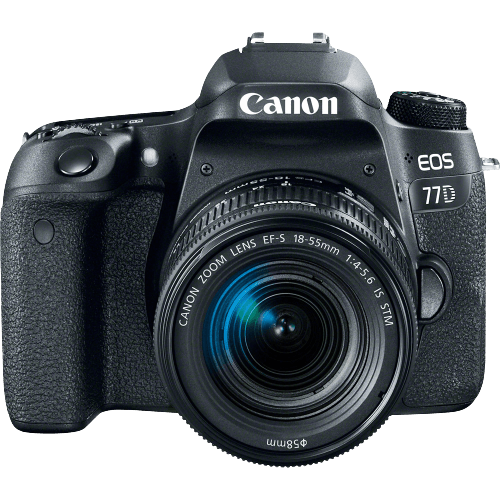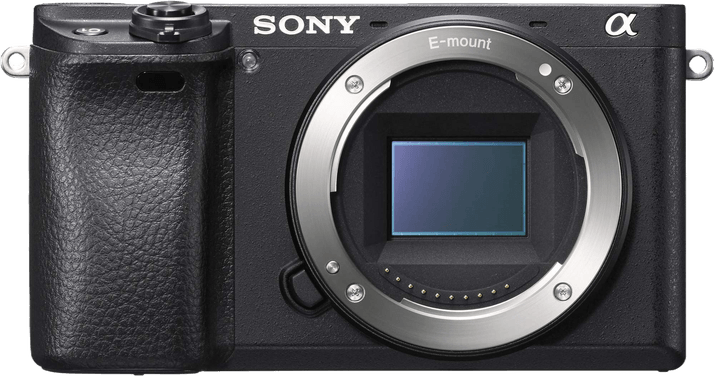Canon EOS 77D vs Sony a6500 Comparison
Canon EOS 77D

Sony a6500

The Sony a6500 takes the lead with a score of 72/100, while the Canon EOS 77D trails behind at 63/100. Both cameras were released in the same time frame, with the Sony a6500 in 2016 and the Canon EOS 77D in 2017. They share similarities in launch price, with the Sony a6500 at $1400 and the Canon EOS 77D at $900.
The Sony a6500 outshines the Canon EOS 77D due to its mirrorless design, making it lighter at 453g and more compact with dimensions of 120 x 67 x 53mm. The Canon EOS 77D, a DSLR camera, weighs 765g and measures 131 x 100 x 76mm. The smaller size and lighter weight of the Sony a6500 make it a more portable option.
However, the Canon EOS 77D has a lower launch price, making it a more budget-friendly option for those who prioritize cost over compactness.
Taking into account the higher score, lighter weight, and compact design, the Sony a6500 emerges as the superior choice. However, the Canon EOS 77D remains a viable option for those seeking a budget-friendly camera.
Canon EOS 77D vs Sony a6500 Overview and Optics
The Sony a6500 outperforms the Canon EOS 77D in optics, with a score of 74/100 compared to the Canon’s 64/100. Both cameras share some common specifications, such as 24.2 megapixels, CMOS sensor type, APS-C sensor size, and their respective lens mounts (Canon EF-S for the 77D and Sony E for the a6500).
The Sony a6500 holds an advantage in several areas. Its shooting speed of 11 frames per second is almost double that of the Canon EOS 77D, which has a speed of 6 frames per second. The a6500 also has a higher DXOMARK sensor score of 85, compared to the 77D’s score of 78. Furthermore, the a6500 features image stabilization, which the 77D lacks. These factors contribute to the a6500’s superior optics performance.
The Canon EOS 77D, however, does have a noteworthy advantage in its processor. It is equipped with the Digic 7 processor, while the Sony a6500 uses the Bionz X processor. This may result in slightly better image processing for the 77D, but ultimately, the difference in processors does not outweigh the advantages the a6500 holds in other areas.
Taking all of these factors into consideration, the Sony a6500 is the clear winner in terms of optics due to its higher shooting speed, better DXOMARK sensor score, and the inclusion of image stabilization. While the Canon EOS 77D does have a more advanced processor, it falls short in the other key aspects of optics performance.
Canon EOS 77D vs Sony a6500 Video Performance
The Sony a6500 emerges as the winner in the video capabilities comparison, scoring 77/100 compared to the Canon EOS 77D’s 70/100. Both cameras share some specifications, such as having Full HD video resolution and built-in time-lapse functionality. However, the Sony a6500 outperforms the Canon EOS 77D in several aspects, while the latter has its own advantages as well.
The Sony a6500 boasts a higher maximum video resolution of 4K (3840 x 2160) compared to the Canon EOS 77D’s Full HD (1920 x 1080). Additionally, the Sony a6500 has a higher maximum video frame rate of 120fps, doubling the Canon EOS 77D’s 60fps. This higher frame rate allows for smoother slow-motion footage and overall better video quality.
On the other hand, the Canon EOS 77D has a built-in time-lapse functionality, which the Sony a6500 lacks. This feature enables users to create time-lapse videos without the need for additional equipment or software, providing added convenience for those interested in this type of videography.
Taking these factors into consideration, the Sony a6500 stands out as the superior option for video capabilities, with its 4K resolution and higher frame rate offering better overall video quality. The Canon EOS 77D, while not as advanced in this area, still provides a useful built-in time-lapse feature that may appeal to certain users. Ultimately, the choice between these two cameras depends on the specific needs and priorities of the individual photographer or videographer.
Canon EOS 77D vs Sony a6500 Features and Benefits
The Sony a6500 outperforms the Canon EOS 77D in features with a score of 81/100 compared to the Canon’s 70/100. Both cameras share several specifications, including a 3-inch screen size, touchscreen capabilities, flip screen, absence of GPS, and the presence of WIFI and Bluetooth connectivity.
The Sony a6500 is superior in screen resolution, offering 921,600 dots compared to the Canon EOS 77D’s 1,040,000 dots. This higher resolution provides a clearer, more detailed view of images and videos on the camera’s display. The Sony a6500’s higher feature score also indicates that it offers more advanced and user-friendly options, making it a more versatile camera for various photography situations.
However, the Canon EOS 77D has some advantages as well. Although its feature score is lower, it might offer specific features that photographers prefer, depending on their individual needs and preferences. Additionally, the lower score does not necessarily mean that the Canon EOS 77D is a poor-quality camera; it simply means that the Sony a6500 has more advanced features.
Taking all factors into consideration, the Sony a6500 is the better camera in terms of features. Its higher feature score and screen resolution make it a more versatile and user-friendly option for photographers of all skill levels. However, the Canon EOS 77D remains a solid choice for those who prioritize specific features or have brand loyalty. Ultimately, the decision between the two cameras depends on individual preferences and photography needs.
Canon EOS 77D vs Sony a6500 Storage and Battery
The Canon EOS 77D outperforms the Sony a6500 in storage and battery with a score of 29/100 compared to Sony’s 21/100. Both cameras share similar storage features, with one memory card slot each and compatibility with SD, SDHC, and SDXC memory cards. However, the Sony a6500 also accepts Memory Stick Pro Duo cards.
The Canon EOS 77D boasts a superior battery life, offering 600 shots per charge, while the Sony a6500 only provides 350 shots. Both cameras use different battery types: the Canon utilizes the LP-E17, whereas the Sony relies on the NP-FW50. Neither camera offers USB charging capabilities.
In terms of storage and battery, the Canon EOS 77D emerges as the clear winner with its longer battery life. Although the Sony a6500 has an additional memory card compatibility, this advantage is not enough to surpass the Canon’s overall performance in this category.
Canon EOS 77D vs Sony a6500 – Our Verdict
Are you still undecided about which camera is right for you? Have a look at these popular comparisons that feature the Canon EOS 77D or the Sony a6500:

